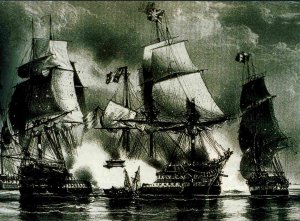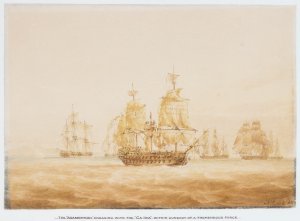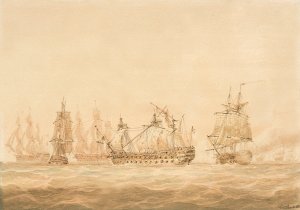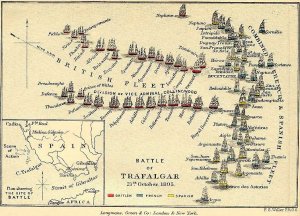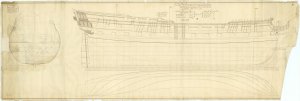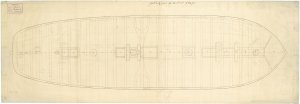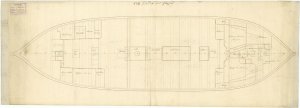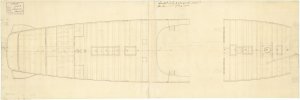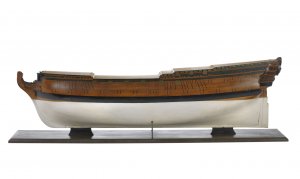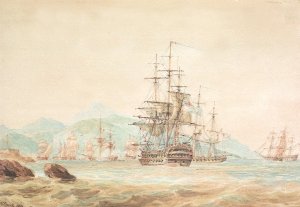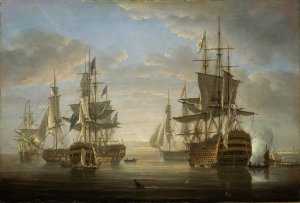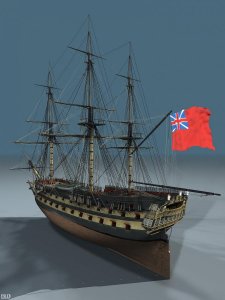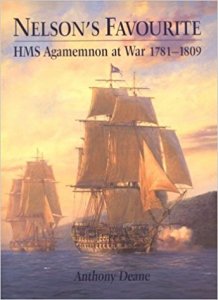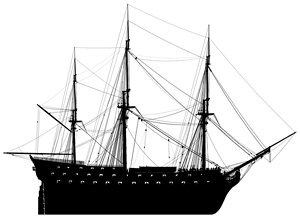HMS Agamemnon (1781 - 1809) / 64 gun Ship of the Line / Ardent class
HMS Agamemnon was a 64-gun third-rate ship of the line of the British Royal Navy. She saw service in the Anglo-French War, French Revolutionary and Napoleonic Wars, and fought in many of the major naval battles of those conflicts. She is remembered as being Nelson's favourite ship, and was named after the mythical ancient Greek king Agamemnon, being the first ship of the Royal Navy to bear the name.
The future Lord Nelson served as Agamemnon's captain from January 1793 for 3 years and 3 months, during which time she saw considerable service in the Mediterranean. After Nelson's departure, she was involved in the infamous 1797 mutinies at Spithead and the Nore, and in 1801 was present at the first Battle of Copenhagen, but ran aground before being able to enter the action.
Despite Nelson's fondness for the ship, she was frequently in need of repair and refitting, and would likely have been hulked or scrapped in 1802 had war with France not recommenced. She fought at the Battle of Trafalgar on 21 October 1805, as part of Nelson's weather column, where she forced the surrender of the Spanish four-decker Santísima Trinidad. Agamemnon's later career was served in South American waters off Brazil.
Her worn-out and poor condition contributed to her being wrecked when in June 1809 she grounded on an uncharted shoal in the mouth of the River Plate, whilst seeking shelter with the rest of her squadron from a storm. All hands and most of the ship's stores were saved, but the condition of the ship's timbers made it impossible to free the ship; her captain was cleared of responsibility for the ship's loss thanks to documents detailing her defects. Recently, the wreck of Agamemnon has been located, and several artefacts have been recovered, including one of her cannons.
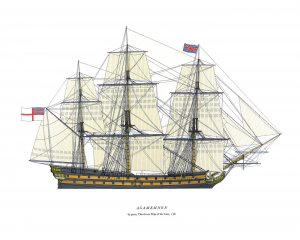
Print of Agamamnon 1781 by http://www.hughevelynprints.com/ship-fleet/hms-agamemnon-1781
Actions she particpated:
Battle of Ushant, 1781
Battle of the Saintes, 1782
Battle of Genoa, 1795
Battle of the Hyères Islands, 1795
Battle of Copenhagen, 1801
Battle of Cape Finisterre, 1805
Battle of Trafalgar, 1805
Battle of San Domingo, 1806
Battle of Copenhagen, 1807
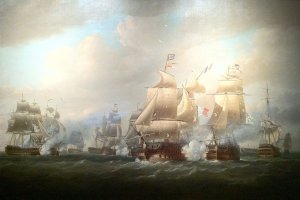
"Duckworth's Action off San Domingo, 6 February 1806" by Nicholas Pocock. HMS Agamemnon is visible in the background, third from left.
Construction
Agamemnon was ordered from the commercial shipbuilder Henry Adams at his Bucklers Hard shipyard on the Beaulieu River on 5 February 1777, to be built to the lines of the Ardent class, as designed by Sir Thomas Slade. Her keel was laid down in May. She was constructed using timber sourced from the surrounding New Forest. The total cost of her construction was £38,303 15s 4d. She was commissioned on 28 March 1781 under Captain Benjamin Caldwell—a full 13 days before her launch on 10 April.
She was named after King Agamemnon, a prominent figure in ancient Greek mythology who participated in the Siege of Troy, and was the first Royal Navy vessel to bear the name. Lord Nelson regarded her as his favourite ship, and to her crew she was known by the affectionate nickname 'Eggs–and–Bacon'. According to an article in The Gentleman's Magazine, her crew renamed her as they did not like the classical names that were in vogue at the Admiralty during this period (the crews of Bellerophon and Polyphemus also 'renamed' their ships, to 'Billy Ruffian' and 'Polly Infamous' respectively, for the same reason).
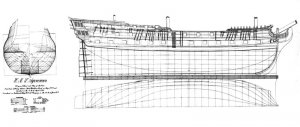
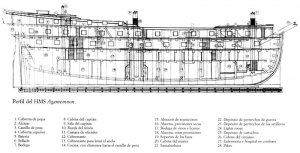
by http://www.histarmar.com.ar/HYAMNEWS/Hyam 2004/HY31-Agamemnon.htm
2004/HY31-Agamemnon.htm
Anglo-French War
In November 1781, the Admiralty had received intelligence that a large convoy was preparing to sail from Brest under Admiral de Guichen. The convoy was composed of transports carrying naval supplies for the West Indies and the French fleet in the East Indies. Agamemnon was part of Admiral Richard Kempenfelt's squadron of 18 ships (11 of which mounted 64 or more guns), which he commanded from HMS Victory. Kempenfelt was ordered to intercept the convoy, which he did in the afternoon of 12 December in the Bay of Biscay, approximately 150 miles (241.4 km) south-west of Ushant. With the French naval escort to leeward of the convoy, Kempenfelt attacked immediately, capturing 15 of the transports before nightfall. The rest of the convoy scattered, most returning to Brest; only five transports reached the West Indies.
Early in 1782, she sailed to the West Indies as part of Admiral Sir George Rodney's squadron, with Rear-Admiral Sir Samuel Hood as his second in command. On 9 April, the Battle of the Saintes began with an indecisive skirmish, in which the ships of the vanguard division, under Hood's command, were badly damaged and forced to withdraw to make repairs. On 12 April, Agamemnon took part in the second action, which proved much more decisive. Over the course of the battle, Agamemnon had 2 lieutenants and 14 crewmen killed, and 22 others were wounded.
After the signing of the Treaties of Versailles brought an end to the Anglo-French War, Agamemnon returned from the West Indies to Chatham, where she was paid off and docked on 29 October 1783 for repairs and to have her copper sheathing replaced. She came out of dock on 4 June 1784, and was subsequently laid up in ordinary.
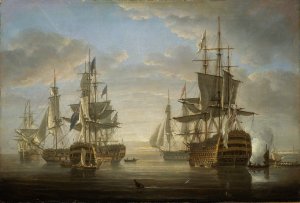
HMS Victory, HMS Captain, HMS Agamemnon, HMS Vanguard & HMS Elephant
HMS Agamemnon was a 64-gun third-rate ship of the line of the British Royal Navy. She saw service in the Anglo-French War, French Revolutionary and Napoleonic Wars, and fought in many of the major naval battles of those conflicts. She is remembered as being Nelson's favourite ship, and was named after the mythical ancient Greek king Agamemnon, being the first ship of the Royal Navy to bear the name.
The future Lord Nelson served as Agamemnon's captain from January 1793 for 3 years and 3 months, during which time she saw considerable service in the Mediterranean. After Nelson's departure, she was involved in the infamous 1797 mutinies at Spithead and the Nore, and in 1801 was present at the first Battle of Copenhagen, but ran aground before being able to enter the action.
Despite Nelson's fondness for the ship, she was frequently in need of repair and refitting, and would likely have been hulked or scrapped in 1802 had war with France not recommenced. She fought at the Battle of Trafalgar on 21 October 1805, as part of Nelson's weather column, where she forced the surrender of the Spanish four-decker Santísima Trinidad. Agamemnon's later career was served in South American waters off Brazil.
Her worn-out and poor condition contributed to her being wrecked when in June 1809 she grounded on an uncharted shoal in the mouth of the River Plate, whilst seeking shelter with the rest of her squadron from a storm. All hands and most of the ship's stores were saved, but the condition of the ship's timbers made it impossible to free the ship; her captain was cleared of responsibility for the ship's loss thanks to documents detailing her defects. Recently, the wreck of Agamemnon has been located, and several artefacts have been recovered, including one of her cannons.

Print of Agamamnon 1781 by http://www.hughevelynprints.com/ship-fleet/hms-agamemnon-1781
Actions she particpated:
Battle of Ushant, 1781
Battle of the Saintes, 1782
Battle of Genoa, 1795
Battle of the Hyères Islands, 1795
Battle of Copenhagen, 1801
Battle of Cape Finisterre, 1805
Battle of Trafalgar, 1805
Battle of San Domingo, 1806
Battle of Copenhagen, 1807

"Duckworth's Action off San Domingo, 6 February 1806" by Nicholas Pocock. HMS Agamemnon is visible in the background, third from left.
Construction
Agamemnon was ordered from the commercial shipbuilder Henry Adams at his Bucklers Hard shipyard on the Beaulieu River on 5 February 1777, to be built to the lines of the Ardent class, as designed by Sir Thomas Slade. Her keel was laid down in May. She was constructed using timber sourced from the surrounding New Forest. The total cost of her construction was £38,303 15s 4d. She was commissioned on 28 March 1781 under Captain Benjamin Caldwell—a full 13 days before her launch on 10 April.
She was named after King Agamemnon, a prominent figure in ancient Greek mythology who participated in the Siege of Troy, and was the first Royal Navy vessel to bear the name. Lord Nelson regarded her as his favourite ship, and to her crew she was known by the affectionate nickname 'Eggs–and–Bacon'. According to an article in The Gentleman's Magazine, her crew renamed her as they did not like the classical names that were in vogue at the Admiralty during this period (the crews of Bellerophon and Polyphemus also 'renamed' their ships, to 'Billy Ruffian' and 'Polly Infamous' respectively, for the same reason).


by http://www.histarmar.com.ar/HYAMNEWS/Hyam
 2004/HY31-Agamemnon.htm
2004/HY31-Agamemnon.htmAnglo-French War
In November 1781, the Admiralty had received intelligence that a large convoy was preparing to sail from Brest under Admiral de Guichen. The convoy was composed of transports carrying naval supplies for the West Indies and the French fleet in the East Indies. Agamemnon was part of Admiral Richard Kempenfelt's squadron of 18 ships (11 of which mounted 64 or more guns), which he commanded from HMS Victory. Kempenfelt was ordered to intercept the convoy, which he did in the afternoon of 12 December in the Bay of Biscay, approximately 150 miles (241.4 km) south-west of Ushant. With the French naval escort to leeward of the convoy, Kempenfelt attacked immediately, capturing 15 of the transports before nightfall. The rest of the convoy scattered, most returning to Brest; only five transports reached the West Indies.
Early in 1782, she sailed to the West Indies as part of Admiral Sir George Rodney's squadron, with Rear-Admiral Sir Samuel Hood as his second in command. On 9 April, the Battle of the Saintes began with an indecisive skirmish, in which the ships of the vanguard division, under Hood's command, were badly damaged and forced to withdraw to make repairs. On 12 April, Agamemnon took part in the second action, which proved much more decisive. Over the course of the battle, Agamemnon had 2 lieutenants and 14 crewmen killed, and 22 others were wounded.
After the signing of the Treaties of Versailles brought an end to the Anglo-French War, Agamemnon returned from the West Indies to Chatham, where she was paid off and docked on 29 October 1783 for repairs and to have her copper sheathing replaced. She came out of dock on 4 June 1784, and was subsequently laid up in ordinary.

HMS Victory, HMS Captain, HMS Agamemnon, HMS Vanguard & HMS Elephant



